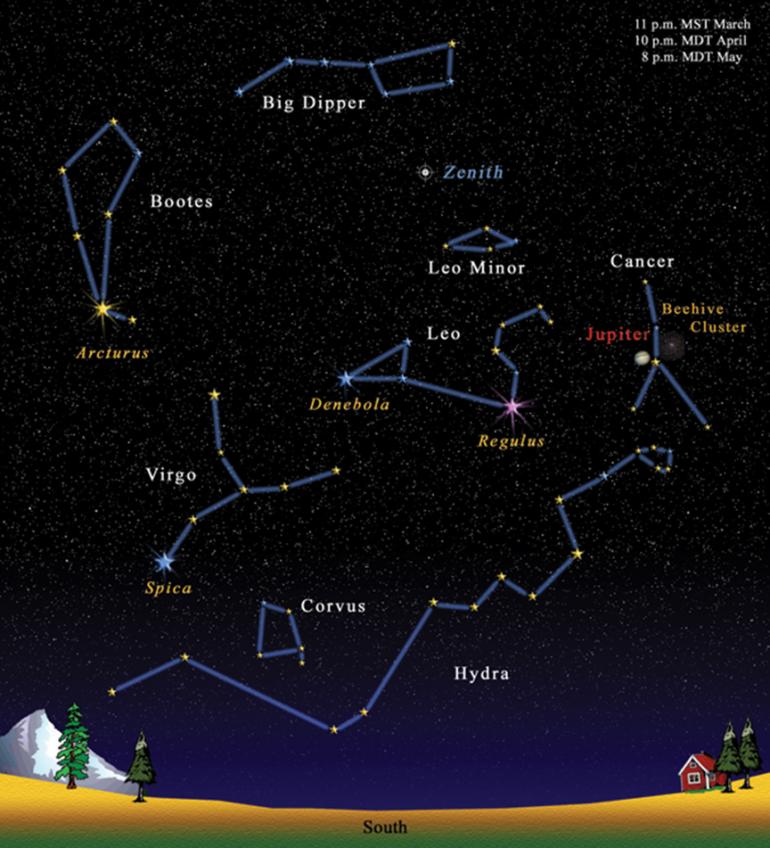Night Prowlers
Ah, spring! The time of year when robins return and gophers peep their heads out of winter burrows with their little brains turned to thoughts of romance. But while the meek conspire to inherit the earth through sheer reproduction, the springtime sky above is filled with fiercer creatures: lions, tigers, and bears.
Look for the Great Bear swinging just north of overhead in the guise of the Big Dipper, whose bowl and handle form its back and tail. Use the two stars at the front of the bowl to trace a line from base to brim and on toward the northern horizon to find the North Star, marking the end of the handle of the Little Dipper, whose smaller and dimmer dimensions form the tail and body of the Little Bear.
Now kick those Big Dipper “Pointer Stars” into reverse and extend a line out of the bottom of the Dipper southward, and you’ll run smack into the great feline of the sky: Leo the lion riding high in the south, his front half shaped like a sickle or backward question mark of stars, and his back half like a triangle. The star at top of the sickle marks his eye, and the star at the base, named Regulus, marks his heart. On the lion’s other end, the easternmost star of the triangle—locating the tail—is called Denebola. Leo lies due south about 11pm MST in mid-March and 8pm MDT in mid-April. By nightfall in mid-May, he’s already stalking into the west.
Among the Greeks, Leo was said to be the fierce lion whose ravaging of the land of Nemea made him the first item on Hercules’ to-do list when he embarked on his Twelve Labors. Leo was no easy mark, though, for he was impervious to weapons. Hercules tested this out by bouncing an arrow or two off of his hide before wading in with both hands, wrestling the lion into a body lock, and squeezing the life out of him. Thereafter, the Nemean Lion became a fashion accessory for Hercules, who wore Leo’s skin for his remaining labors. Leo, like Hercules, was later put in the sky for his trouble. But for our local landscape, Leo might best make a mountain lion, appropriately leaping out of the Bridger Range on the east side of the valley, where real cougars make their living on the local mule-deer population.
This great kitty of the sky stalks not deer, however, but a fuzzy ball of catnip in the form of the Beehive Cluster, a gathering of some 75 stars located about 500 light years away. It can be glimpsed in a dark sky as a faint, fuzzy patch just west (ahead) of Leo in the faint constellation of Cancer the crab, and a pair of binoculars shows it as a lovely concentration of stars. This year Leo has an additional play toy in the bright planet Jupiter, which lies nearly superimposed on the Beehive Cluster during the springtime months, just to its left.
Neither does Leo prowl the sky alone. Leo Junior (officially Leo Minor) was created by Johannes Hevelius in the 1600s from “leftover” stars between Leo and the Great Bear. Leo Minor is best made out as a flattened diamond of fainter nondescript stars located a little above his daddy’s head. As you make your own springtime prowls, remember to cast an eye toward this pride of two padding softly across the hunting grounds of the sky.
Oh—and the tiger? The Chinese imagined four great beasts stretching around the zodiac, including the White Tiger. The star pattern of Orion, which marks the tiger’s head, can still be seen in the early spring by looking west after dark. Look—and enjoy the fierce creatures of the sky.












